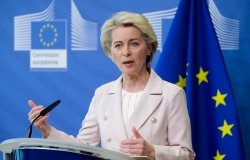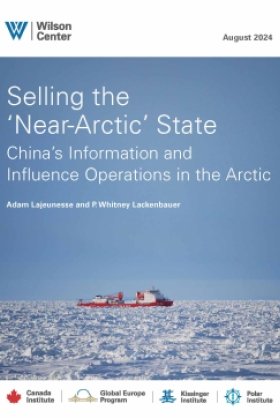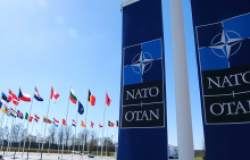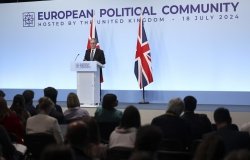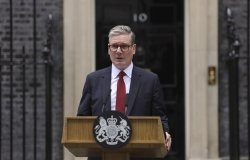324. Media Matters: Professionalizing and Regulating Media in Post-Conflict Bosnia and Kosovo
Robert Gillette was the Temporary Media Commissioner of Kosovo from 2003 to 2006. He spoke at an EES Noon Discussion on June 14, 2006. The following is a summary of his presentation. Meeting Report 324.
It is an article of faith that an independent, diverse and reasonably professional media is an essential fixture of democracy. As irritating as it can sometimes be, fact-based journalism practiced by public-spirited people really does help make the machinery of democracy work. Over the past 15 years, the U.S. and European governments along with private donors, including George Soros, have backed this premise with substantial funds. Since 1990, international donors have spent at least $600 million and probably much more on media training and development in emerging democracies, mostly in Central and Eastern Europe and the former Soviet Union, and more recently in Afghanistan and the Middle East. While in the overall context of international aid $600 million is not a great sum, it is a very substantial resource to be focused on the care and feeding of one particular professional endeavor, in this case journalism, especially one whose normal relationship with government is adversarial.
To the considerable credit of USAID, the State Department and their European and Canadian counterparts, media development has become a standard feature of nation-building and democracy assistance. Moreover, these agencies and many, if not all, independent media-assistance organizations have come to recognize, if only gradually, the interdependence of media and democracy. Media and democracy need each other and prosper only when they develop together. Low media professionalism will do little to secure—and can do much to destabilize—a fragile new democracy. But in order to exercise generally accepted standards of professional, independent journalism, media needs at least a minimally secure legal and political environment in which to operate—what Monroe Price and John Krug called in a perceptive and perhaps under-appreciated study for USAID in 2000, an "enabling environment." Thus, by media development we mean not only nurturing independent, professional journalists but also building a legal and institutional environment to protect, to professionalize and, in carefully limited ways, to regulate media. Unfortunately, this aspect of media development has not received all of the attention it deserves where it has been most needed.
In Central Europe and the Baltic states, where the rule of law quickly took root in the 1990s, early media assistance helped jump-start professionalism and provided useful business skills that paved the way until private investment could take over. American media aid to postcommunist Europe began during the Reagan presidency as a response to the dramatic flowering of new radio and television stations and newspapers that began with the collapse of communism in 1989 and accelerated with the dissolution of the Soviet Union in 1991. Hundreds of new media outlets appeared almost overnight, initially in the region stretching from Estonia to Bulgaria, and later from Ukraine to Kyrgyzstan. Most were authentic expressions of the new freedom: shoestring startups driven by the usual mix of an interest in community service and self-promotion. Slovakia, Bulgaria and Romania were slow starters but have since developed reasonably well in this respect.
By contrast, the return on the investment of external media assistance in the most fragile democracies—namely Kosovo and Bosnia—may be lower than we had hoped, and may indeed never be realized. While most of the many new media there were constructive and public spirited, a few had nefarious purposes, such as money laundering. And a very small number even sought to drive ethnic conflict through the propaganda of hatred, continuing the war by other means. I want to focus on the lessons learned from media development in these two places that posed the hardest tests of nation-building at the time.
There are, as I have suggested, two very different and complementary sides of media development, one of which—media training in journalistic and business skills—has received most of the international community's generous attention. Building a professional media is an easier, more definable task than building a suitable environment for media. Training and equipping promising new newspapers, radio and television stations is a straightforward and uncontroversial technical task. One bets on winners who start with a base of talent, ethical values and entrepreneurial instincts so as to create a critical mass of thoughtful, ethical and survivable media. By and large, this side of media development has worked well in the Balkans, and elsewhere, with solid accomplishment and relatively little waste.
For example, U.S. and other donor funding has been crucial to the emergence and survival of the most professional television, radio and print media in the Serbian language, in Bosnia and in Serbia, including ATV television and the newspaper Nezavisne Novine in Republika Srpska in Bosnia, and B-92 radio and TV in Serbia. In Bosnia, donor money helped local Bosniak, Serb and Croat TV stations launch their own country-wide, multi-ethnic network called Mreza Plus in 2001. USAID funding has created the two most professional private, Albanian-language television broadcasters in Kosovo, TV 21 and KTV and helped the best print media survive the hardest times.
But, in Bosnia and Kosovo, international donors and overseers were slow to grasp that even the most professional and politically independent media, in fact especially the best and the freest, will not survive long without democracy and the rule of law as they apply to media—the enabling environment. Creating an enabling environment involves establishing an interlocking set of laws, as well as regulatory and educational institutions aimed at protecting journalists; to license and otherwise regulate broadcasting according to democratic principles; and to protect the public from the worst kinds of journalism, usually through modern civil libel law and, according to the European model, codes of conduct.
Building a protective, nurturing legal and institutional environment is both a technical and political challenge. It requires astute local partners in central governments and parliaments who are willing to release what instinct tells them is a rightful and necessary chokehold on troublesome media. In Kosovo, for instance, one of our early challenges was to persuade the staff of a controlling Prime Minister that Kosovo did not need a single, overarching law on media that would, among other things, require all journalists to be registered with a regulatory agency that could end their careers with the stroke of a pen.
The task of building a body of democratic media law and regulation becomes even more challenging where the rule of law in general is at a low ebb and corruption and oligarchy prevail; where the trauma of ethnic conflict is still fresh; and where the formative experience of most young journalists is not journalism school, where one learns the crafts of fact-based reporting and analysis, but war. In Kosovo and Bosnia, after a slow start and years of effort, the enabling environments for media are now in place, but they remain vulnerable to continued political turmoil and generic weaknesses in the rule of law throughout the region. Moreover, even when it is established, there is no assurance that a diverse and independent media sector can be maintained over time.
Once the international regents of Bosnia and later in Kosovo awoke to the need for a body of media law and regulation—awakenings driven in both cases by media-related crises—policy disputes erupted within the international community, over the heads of the governments they were supposed to be guiding, that in Bosnia complicated and slowed progress and, in Kosovo, paralyzed progress for nearly five years.
Neglect of the enabling environment was not only unfortunate but also perplexing, given that the international community knew full well that media, chiefly in Belgrade, had played a crucial catalytic role in the Yugoslav conflict in the late 1980s by systematically generating an atmosphere of fear of the "others" that eventually made war seem not only acceptable but also patriotic. Controlled state media had enabled ethnic conflict. The late Warren Zimmermann, the last US ambassador to an intact Yugoslavia, recalled with some irony sensational, if absurd, news reports on Belgrade television of Croat men kicking around Serb skulls as a substitute soccer ball while Croatian television in Zagreb more or less simultaneously reported the same shocking if apocryphal story in reverse—Serb men kicking around Croat skulls. Neither report, of course, included verifiable fact or explained how, if any of this were actually true, one could tell a Serb skull from a Croat skull. It was simply part of the daily propaganda drumbeat of hatred and ultimately of war. Nevertheless, the media was not seen as a priority in the nation-building project: it was not mentioned at all in the Dayton Accords that ended the war in 1995.
In Bosnia, two years passed before the High Representative awakened to the need for systematic media regulation. The wakeup call was the realization, weeks before fall 1997 elections, that Radovan Karadzic, who controlled the remnants of old media—Yugoslav state television and radio in the Republika Srpska—was making effective use of his assets. His winning formula had much to do with Serb nationalism and the denigration of others, including the international community. In the absence of anything resembling a normal European broadcast regulator, the High Representative had no alternative but to call on SFOR, the NATO-led stabilization force, to conduct an armed raid on Karadzic's television headquarters in Pale and forcibly transfer control of Bosnian Serb television to the international community's favored candidates, Biljana Plavsic and Milorad Dodik in Banja Luka.
This blunt-force approach to media regulation worked, but it caused predictable outrage among international human rights groups, which embarrassed SFOR. The Office of High Representative then moved quickly to recruit a small group of international experts to organize an authentic, independent regulatory agency—Bosnia's first. I was privileged to be part of that group. We arrived in the summer of 1998 to discover that no one even knew how many radio and TV stations were operating in Bosnia, let alone what they were broadcasting. Our first task was a census that found 280 radio and television stations serving a population of perhaps 3.5 million, or roughly twice the number of radio and TV stations per capita as the United States. The huge numbers were easy to explain: Three separate ethnic centers of power in Bosnia—Serbs in the north, Croats in the south, Bosniaks in the middle—were freely handing out licenses without regard to the others except when deliberate jamming was the aim. For instance, Radio Sveti Jovan, a radio station licensed by Serb authorities, was funded by the Orthodox church and run by Radovan Karadzic's wife and daughter. Not by coincidence, Sveti Jovan operated on the same frequency in Pale as a human rights oriented station funded by George Soros in nearby Sarajevo.
Within about 18 months, the new regulatory agency, the Independent Media Commission (IMC), had established Bosnia's first western-style regulatory regime. The IMC consciously presented a model of an open, transparent, consultative and multi-ethnic regulatory agency. This was a new experience for broadcasters. It sorted out the interference mess, won their grudging respect and enforced a code of ethics that suppressed the few remaining sources of hate propaganda. Thanks to a dedicated local staff, good advice from experienced U.S. and British regulators and brave and distinguished Bosnians who agreed to serve on the IMC's first governing Council, the IMC (now the Communications Regulatory Agency) today is the most independent and professional broadcast and telecom regulator in the Western Balkans.
Yet, its continued independence and professionalism will not be assured as long as the strength of Bosnia's parliamentary commitment to the rule of law remains questionable. Paddy Ashdown, the former High Representative in Bosnia, recognized that the rule of law had been grievously overlooked. "We thought that democracy was the highest priority, and we measured it by the number of elections we could organize," Ashdown said in a New York Times op-ed article on October 28, 2002. "The result seven years later is that the people of Bosnia have grown weary of voting [and] the focus on elections slowed our efforts to tackle organized crime and corruption, which have jeopardized quality of life and scared off foreign investment."
"In hindsight," he wrote, "we should have put rule of law first, for everything else depends on it: a functioning economy, the development of civil society, public confidence in police and the courts."
In Kosovo, during the chaotic summer of 1999, the newly established UN mission under Bernard Kouchner seemed determined not to repeat Bosnia's inattention to media law and regulation. The UN assigned the Organization for Security and Cooperation in Europe (OSCE) the responsibility for building democratic institutions including media regulators, which in turn asked the IMC in Sarajevo for a simple plan to replicate the Bosnian agency on a smaller scale in Kosovo. According to the IMC plan, the OSCE set to build its own Independent Media Commission for Kosovo in August, 1999, to be governed by a multi-ethnic Council of distinguished local citizens and internationals, as in Bosnia.
Just as the plan was being implemented, the New York Times published an article on August 16, 1999 followed by similar editorial on August 30 accusing the UN mission in Kosovo of preparing to repeat the Bosnian "mistake" of setting up a Ministry of Information, which the article contended would reintroduce censorship. Utterly wrong though the New York Times was, the project to create a media regulating institution for Kosovo was stopped in its tracks and a year would pass before the UN's thoughts would turn again to media law and regulation.
Once again, crisis was the stimulus. In this case, renewed interest in regulating the media was a response to so-called "vigilante journalism." Two newspapers based in Pristina published photographs and other identifying information of people they declared to be Serb collaborators, with the implicit suggestion that someone would surely know what to do with this information. When one alleged collaborator was shot and killed and at least one other was wounded, the UN Mission moved almost overnight, in June 2000, to create the institution of the Temporary Media Commissioner or TMC.
Appointed by the UN mission chief, the Special Representative of the Secretary General (SRSG), the TMC was armed with codes of ethics for broadcast media and newspapers (a quasi state authority unique in Europe), the power to levy fines up to 50,000 euros per violation and a sweeping if vague mandate to bring about an independent and professional media in Kosovo and the implementation of a temporary regulatory regime for all media in Kosovo—the very thing that the New York Times had denounced a year earlier.
Creating a single media commissioner was expedient but, arguably, not very democratic, although the TMC's authority was effectively tempered by an independent, three-judge Media Appeals Board whose affirmation was required to make any enforcement action or denial of license effective. Moreover, investing regulatory authority in the hands of one "Komisar"—to use the Serbian translation of the title—led inevitably to the impression that the TMC's regulatory actions were not so much the product of the rule of law as of his or her personal whim. Despite the nominally temporary nature of the TMC, inertia and the inevitable policy disputes in the international community stretched the life of the Office of the TMC over five years, stymied progress in developing a permanent body of domestic media law and regulation and in the end made it all the more difficult to establish a permanent Kosovo regulatory commission that could win respect and credibility.
Meanwhile, media development—the money and training side of the equation—proceeded quickly and generously from 2000 onward. As in Bosnia, Europe and Japan focused exclusively funding a new public broadcaster, Radio-Television Kosovo or RTK, at a cost of nearly $20 million. Meanwhile, USAID spent millions to help create two competing Kosovo-wide private, commercial networks, KTV and TV 21. The result has been a healthy competitive balance between public and private TV. Over a three year-period, successive Temporary Media Commissioners licensed 110 local radio and TV stations, roughly the same per capita proportion as we found in Bosnia. Significantly, a third of Kosovo's broadcasters are Serb stations (in contrast to the approximately 5 percent of the population represented by Serbs) and nearly 40 percent provide programming in at least two of the languages spoken in Kosovo. One positive result of these policies is the breadth and diversity of local broadcast services to minority communities in Kosovo, which is far superior to that found in much of Europe.
By contrast, the first three years of international administration in Kosovo accomplished almost nothing in the way of building domestic media law, regulation or educational institutions. It was as if the UN and the OSCE planned to administer Kosovo forever. The Office of the TMC, operating as an arm of the OSCE's media development program, largely ignored broadcasters and focused instead almost entirely on the foibles of Kosovo's six newspapers which were, after all, more visible to the international community and easier to monitor than a hundred local radio and TV stations (none of which, fortunately, dedicated themselves to ethnic propaganda.) The two newspapers that had pioneered vigilante journalism soon died off, leaving successive media commissioners to invest most of their time and energy in a more sophisticated (but no less virulent) publication, Bota Sot. Published in Zurich, it is the dominant newspaper among the Kosovo Albanian diaspora and probably (there are no audited circulation figures) the number two newspaper in Kosovo itself. Often vicious, invariably propagandistic, yet seemingly carefully lawyered, Bota Sot lionized President Ibrahim Rugova, whose own shy and pacific character seemed quite at odds with the newspaper. Over the years, Bota Sot paid more than 50,000 euros in TMC fines (and still owes some 75,000 euros) most of which would never have been imposed if the newspaper had agreed to publish a correction or had offered its targets a right of reply. Instead, it seemed to treat the fines as just another business expense.
The events of March, 2004, offered another crisis which would serve as the catalyst for progress in media law and institution-building. In this case, RTK television broadcasts blamed the drowning deaths of three Albanian boys near the ethnically divided city of Mitrovica on an attack by unidentified Serbs. Having committed the elementary error of treating an assumption as established fact, driven by a perception that its mission was one of patriotic mobilization for Kosovo's independence, and in utter disregard of an explosive social situation, RTK television hammered the theme of ethnic attack for hours into the night of March 16, including a riverside interview with the father of one of the boys, who declared his son, the body freshly dragged from the water, a victim of "Serb Chetnik hordes." Although this report was unfounded, the story triggered three catastrophic days of anti-Serb rioting in Kosovo. Hundreds of homes were burned, dozens of historic Orthodox churches were damaged or destroyed and drove some 4,000 people (mostly minority Serbs) out of their homes and forced them to look for shelter on KFOR bases. NATO troops were surprised by and unprepared for civil disturbance.
The March riots reflected failures on every level, including obviously the failure of the media regulator to prevent appallingly bad journalism. We spent the next six weeks documenting precisely what went wrong with the television coverage, while RTK managers, worried that they might face criminal incitement charges (as they probably should have) defiantly claimed to have done a splendid job of reporting. A number of prominent politicians, perhaps embarrassed to have been drawn into a frenzy of anti-Serb denunciations, rallied around RTK.
By mid-2005, the shock of the riots had helped to prompt salutary progress on the creation of media laws and institution-building. OSCE, having withdrawn its international advisers to the public broadcaster in 2002 as a mission accomplished, restored them (over the protests of RTK). RTK agreed to commit 100,000 euros to its own staff training, only part of which has thus far been accomplished. The Office of the TMC, OSCE and the Office of the Prime Minister jointly drafted and navigated key pieces of media legislation through the Kosovo Assembly, including a law on the creation of a permanent broadcast regulator—the Independent Media Commission for Kosovo—making it finally possible to terminate the institution of the TMC. Progress was also made on legislation providing a legal foundation, with a clearly defined public-service mission for the public broadcaster and a modern civil libel law, to decriminalize defamation. The TMC and the OSCE helped print media organize a voluntary Press Council, to apply its own code of ethics in place of the TMC. The OSCE and European donors also moved within a year to help establish Kosovo's first university-level journalism degree program and are working on building a Kosovo-run center for the training of working journalists, according to models that are already operating in neighboring countries. Moreover, there were encouraging signs that journalists themselves had learned hard lessons from the riots about the need to verify controversial allegations.
Through the crisis, the Council of Europe and the European Commission provided fast, efficient expert advice and review, and have used their leverage artfully to ensure passage of good media laws. Finally, a system of public financing for public broadcasting was set up through the existing system of domestic electric bill administration, which the Office of TMC helped establish in 2003. This system is expected to yield six million euros, or 90 percent of RTK's operating costs this year. Of this, 300,000 euros, or 5 percent, will go into a special fund to support minority and multi-ethnic media, which will help to ensure the survival of Kosovo's numerous minority media even after international donors withdraw. An independent advisory board has already awarded 50,000 euros in minority grants, mostly to Serb broadcasters.
Although several years late, the rule of law is now largely in place for media in Kosovo. Yet political forces have by no means given up their ambitions to control media, and the overall rule-of-law framework remains fragile. Almost certainly, Kosovo will achieve conditional independence late this year or early in 2007. It remains unclear who or what will supplant the UN to ensure security and safeguard the rule of law, which is so crucial for self-sustaining democracy and free, professional media. In Kosovo, as in Bosnia, the United States, having led the interventions that stopped the bloodshed, continues to exercise enormous moral force, while Europe's leverage is the prospect of eventual European Union membership. The advocates of free, independent and professional media can only hope that until that distant day, when the rule of law will be secured as the price of EU membership, America's and Europe's attention will not wander again.
About the Author
Robert Gillette
Read More
Global Europe Program
The Global Europe Program is focused on Europe’s capabilities, and how it engages on critical global issues. We investigate European approaches to critical global issues. We examine Europe’s relations with Russia and Eurasia, China and the Indo-Pacific, the Middle East and Africa. Our initiatives include “Ukraine in Europe” – an examination of what it will take to make Ukraine’s European future a reality. But we also examine the role of NATO, the European Union and the OSCE, Europe’s energy security, transatlantic trade disputes, and challenges to democracy. The Global Europe Program’s staff, scholars-in-residence, and Global Fellows participate in seminars, policy study groups, and international conferences to provide analytical recommendations to policy makers and the media. Read more
